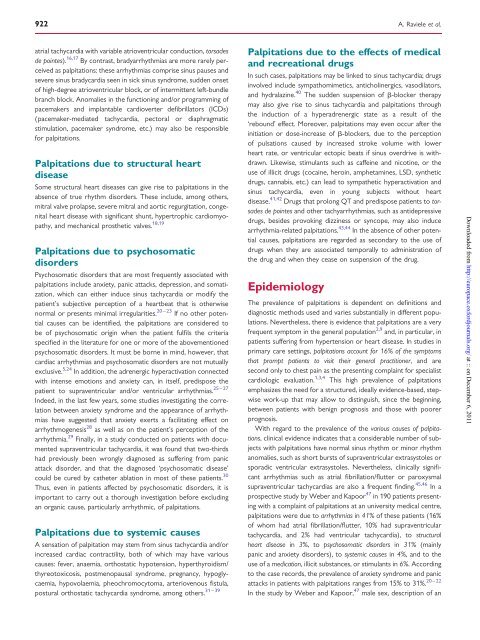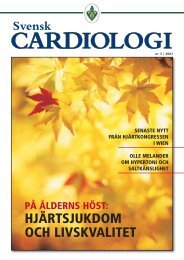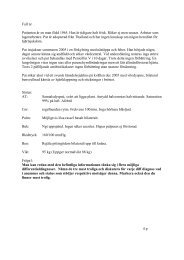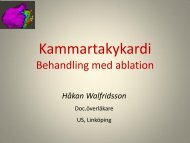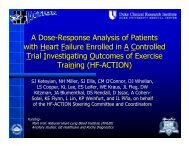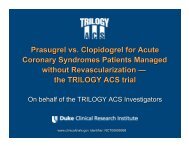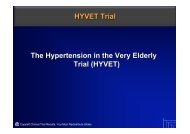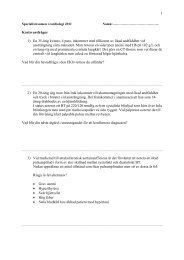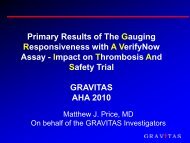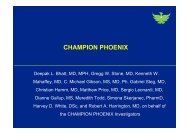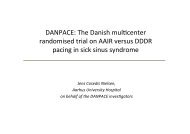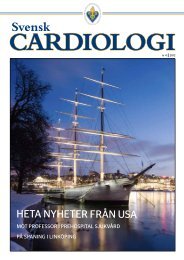Management of patients with palpitations: a position paper from the ...
Management of patients with palpitations: a position paper from the ...
Management of patients with palpitations: a position paper from the ...
Create successful ePaper yourself
Turn your PDF publications into a flip-book with our unique Google optimized e-Paper software.
922A. Raviele et al.atrial tachycardia <strong>with</strong> variable atrioventricular conduction, torsadesde pointes). 16,17 By contrast, bradyarrhythmias are more rarely perceivedas <strong>palpitations</strong>: <strong>the</strong>se arrhythmias comprise sinus pauses andsevere sinus bradycardia seen in sick sinus syndrome, sudden onset<strong>of</strong> high-degree atrioventricular block, or <strong>of</strong> intermittent left-bundlebranch block. Anomalies in <strong>the</strong> functioning and/or programming <strong>of</strong>pacemakers and implantable cardioverter defibrillators (ICDs)(pacemaker-mediated tachycardia, pectoral or diaphragmaticstimulation, pacemaker syndrome, etc.) may also be responsiblefor <strong>palpitations</strong>.Palpitations due to structural heartdiseaseSome structural heart diseases can give rise to <strong>palpitations</strong> in <strong>the</strong>absence <strong>of</strong> true rhythm disorders. These include, among o<strong>the</strong>rs,mitral valve prolapse, severe mitral and aortic regurgitation, congenitalheart disease <strong>with</strong> significant shunt, hypertrophic cardiomyopathy,and mechanical pros<strong>the</strong>tic valves. 18,19Palpitations due to psychosomaticdisordersPsychosomatic disorders that are most frequently associated <strong>with</strong><strong>palpitations</strong> include anxiety, panic attacks, depression, and somatization,which can ei<strong>the</strong>r induce sinus tachycardia or modify <strong>the</strong>patient’s subjective perception <strong>of</strong> a heartbeat that is o<strong>the</strong>rwisenormal or presents minimal irregularities. 20 – 23 If no o<strong>the</strong>r potentialcauses can be identified, <strong>the</strong> <strong>palpitations</strong> are considered tobe <strong>of</strong> psychosomatic origin when <strong>the</strong> patient fulfils <strong>the</strong> criteriaspecified in <strong>the</strong> literature for one or more <strong>of</strong> <strong>the</strong> abovementionedpsychosomatic disorders. It must be borne in mind, however, thatcardiac arrhythmias and psychosomatic disorders are not mutuallyexclusive. 5,24 In addition, <strong>the</strong> adrenergic hyperactivation connected<strong>with</strong> intense emotions and anxiety can, in itself, predispose <strong>the</strong>25 – 27patient to supraventricular and/or ventricular arrhythmias.Indeed, in <strong>the</strong> last few years, some studies investigating <strong>the</strong> correlationbetween anxiety syndrome and <strong>the</strong> appearance <strong>of</strong> arrhythmiashave suggested that anxiety exerts a facilitating effect onarrhythmogenesis 28 as well as on <strong>the</strong> patient’s perception <strong>of</strong> <strong>the</strong>arrhythmia. 29 Finally, in a study conducted on <strong>patients</strong> <strong>with</strong> documentedsupraventricular tachycardia, it was found that two-thirdshad previously been wrongly diagnosed as suffering <strong>from</strong> panicattack disorder, and that <strong>the</strong> diagnosed ‘psychosomatic disease’could be cured by ca<strong>the</strong>ter ablation in most <strong>of</strong> <strong>the</strong>se <strong>patients</strong>. 30Thus, even in <strong>patients</strong> affected by psychosomatic disorders, it isimportant to carry out a thorough investigation before excludingan organic cause, particularly arrhythmic, <strong>of</strong> <strong>palpitations</strong>.Palpitations due to systemic causesA sensation <strong>of</strong> palpitation may stem <strong>from</strong> sinus tachycardia and/orincreased cardiac contractility, both <strong>of</strong> which may have variouscauses: fever, anaemia, orthostatic hypotension, hyperthyroidism/thyreotoxicosis, postmenopausal syndrome, pregnancy, hypogly-Palpitationscaemia, hypovolaemia, pheochromocytoma, arteriovenous fistula,31 – 39postural orthostatic tachycardia syndrome, among o<strong>the</strong>rs.due to <strong>the</strong> effects <strong>of</strong> medicaland recreational drugsIn such cases, <strong>palpitations</strong> may be linked to sinus tachycardia; drugsinvolved include sympathomimetics, anticholinergics, vasodilators,and hydralazine. 40 The sudden suspension <strong>of</strong> b-blocker <strong>the</strong>rapymay also give rise to sinus tachycardia and <strong>palpitations</strong> through<strong>the</strong> induction <strong>of</strong> a hyperadrenergic state as a result <strong>of</strong> <strong>the</strong>‘rebound’ effect. Moreover, <strong>palpitations</strong> may even occur after <strong>the</strong>initiation or dose-increase <strong>of</strong> b-blockers, due to <strong>the</strong> perception<strong>of</strong> pulsations caused by increased stroke volume <strong>with</strong> lowerheart rate, or ventricular ectopic beats if sinus overdrive is <strong>with</strong>drawn.Likewise, stimulants such as caffeine and nicotine, or <strong>the</strong>use <strong>of</strong> illicit drugs (cocaine, heroin, amphetamines, LSD, syn<strong>the</strong>ticdrugs, cannabis, etc.) can lead to sympa<strong>the</strong>tic hyperactivation andsinus tachycardia, even in young subjects <strong>with</strong>out heartdisease. 41,42 Drugs that prolong QT and predispose <strong>patients</strong> to torsadesde pointes and o<strong>the</strong>r tachyarrhythmias, such as antidepressivedrugs, besides provoking dizziness or syncope, may also inducearrhythmia-related <strong>palpitations</strong>. 43,44 In <strong>the</strong> absence <strong>of</strong> o<strong>the</strong>r potentialcauses, <strong>palpitations</strong> are regarded as secondary to <strong>the</strong> use <strong>of</strong>drugs when <strong>the</strong>y are associated temporally to administration <strong>of</strong><strong>the</strong> drug and when <strong>the</strong>y cease on suspension <strong>of</strong> <strong>the</strong> drug.EpidemiologyThe prevalence <strong>of</strong> <strong>palpitations</strong> is dependent on definitions anddiagnostic methods used and varies substantially in different populations.Never<strong>the</strong>less, <strong>the</strong>re is evidence that <strong>palpitations</strong> are a veryfrequent symptom in <strong>the</strong> general population 2,9 and, in particular, in<strong>patients</strong> suffering <strong>from</strong> hypertension or heart disease. In studies inprimary care settings, <strong>palpitations</strong> account for 16% <strong>of</strong> <strong>the</strong> symptomsthat prompt <strong>patients</strong> to visit <strong>the</strong>ir general practitioner, and aresecond only to chest pain as <strong>the</strong> presenting complaint for specialistcardiologic evaluation. 1,3,4 This high prevalence <strong>of</strong> <strong>palpitations</strong>emphasizes <strong>the</strong> need for a structured, ideally evidence-based, stepwisework-up that may allow to distinguish, since <strong>the</strong> beginning,between <strong>patients</strong> <strong>with</strong> benign prognosis and those <strong>with</strong> poorerprognosis.With regard to <strong>the</strong> prevalence <strong>of</strong> <strong>the</strong> various causes <strong>of</strong> <strong>palpitations</strong>,clinical evidence indicates that a considerable number <strong>of</strong> subjects<strong>with</strong> <strong>palpitations</strong> have normal sinus rhythm or minor rhythmanomalies, such as short bursts <strong>of</strong> supraventricular extrasystoles orsporadic ventricular extrasystoles. Never<strong>the</strong>less, clinically significantarrhythmias such as atrial fibrillation/flutter or paroxysmalsupraventricular tachycardias are also a frequent finding. 45,46 In aprospective study by Weber and Kapoor 47 in 190 <strong>patients</strong> presenting<strong>with</strong> a complaint <strong>of</strong> <strong>palpitations</strong> at an university medical centre,<strong>palpitations</strong> were due to arrhythmias in 41% <strong>of</strong> <strong>the</strong>se <strong>patients</strong> (16%<strong>of</strong> whom had atrial fibrillation/flutter, 10% had supraventriculartachycardia, and 2% had ventricular tachycardia), to structuralheart disease in 3%, to psychosomatic disorders in 31% (mainlypanic and anxiety disorders), to systemic causes in 4%, and to <strong>the</strong>use <strong>of</strong> a medication, illicit substances, or stimulants in 6%. Accordingto <strong>the</strong> case records, <strong>the</strong> prevalence <strong>of</strong> anxiety syndrome and panic20 – 22attacks in <strong>patients</strong> <strong>with</strong> <strong>palpitations</strong> ranges <strong>from</strong> 15% to 31%.In <strong>the</strong> study by Weber and Kapoor, 47 male sex, description <strong>of</strong> anDownloaded <strong>from</strong> http://europace.oxfordjournals.org/ at :: on December 6, 2011


